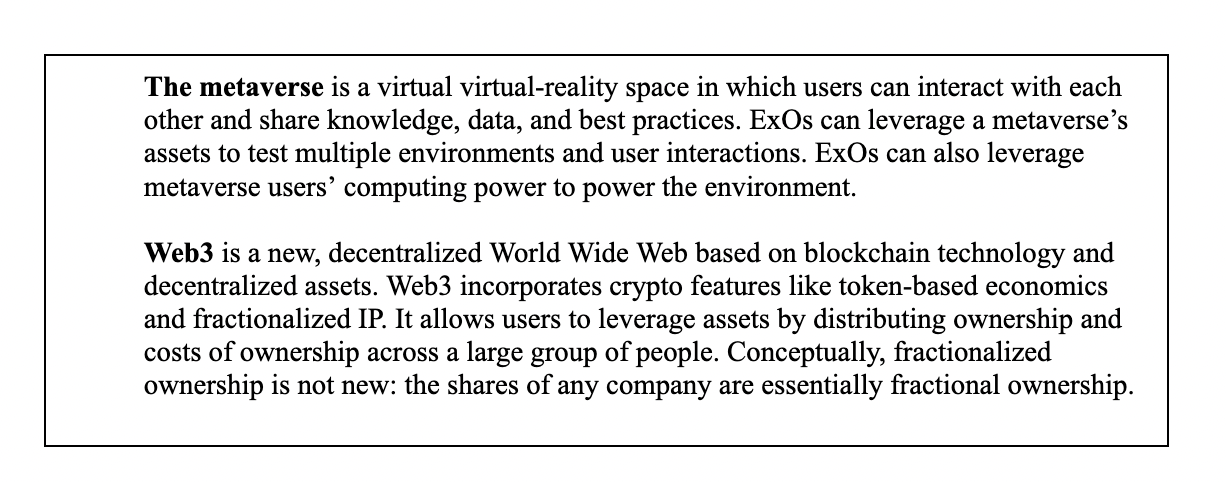Metatrends
The convergence of exponentially growing technologies, especially artificial intelligence, will reinvent every business model and accelerate the global pace of change. Such convergence will disrupt old industries and create a multitude of new trillion-dollar opportunities in the coming decade.
In order for exponential entrepreneurs to surf on top of this tsunami of change rather than being crushed by it, it is critical to understand the key metatrends shaping the decade ahead.
Peter has created a list of ten such metatrends that are likely to define the period between 2023 and 2033. Paying attention to these trends is how an entrepreneur can peer around the corner and see the future.
-
The rise of artificial intelligence (AI). Artificial intelligence is projected by Ray Kurzweil, Elon Musk, and the team at Google’s DeepMind to reach human-level performance before the end of this decade. Today, large language models such as Open AI’s GPT-4, Google’s BARD, and NVIDIA’s Megatron-Turing NLG are increasing tenfold in capability every year. In 2022, DeepMind announced Gato-AI, a “generalist agent” AI that is able to carry out complex tasks from stacking blocks to writing poetry. Later in 2022, OpenAI rolled out ChatGPT and took the internet by storm, followed rapidly by AutoGPT. AI is expected to penetrate every industry and product. Combined with the explosion of low-cost microscopic sensors, the deployment of high-bandwidth networks, and the connection to AI cloud services, every device will soon become intelligent. A toy remembers a child’s face and name. Appliances respond to voice commands and anticipate user needs.
-
AI, robotic, and human collaboration. The rise of “AI as a Service” (AIaaS) platforms will enable humans to partner with AI in every aspect of their work, at every level, in every industry. Reid Hoffman, founder of LinkedIn™, predicts that by 2028, every profession will have an “AI-Copilot” available. AI technologies will become entrenched in everyday business operations, serving as cognitive collaborators to employees: supporting creative tasks, generating new ideas, and tackling previously unattainable innovations. At the same time, humanoid robots are expected to flourish in the decade ahead. Whether fully autonomous, driven by GPT-4 or GPT-5, or human-driven avatars, these robots will take on jobs that are dull, dangerous, or dirty. The most famous is Tesla Bot (also known as Optimus), which Elon Musk announced in 2022 as Tesla’s most important future product. “Optimus will upend our idea of what the economy is … It will be able to do basically anything humans don’t want to do… It’s going to bring an age of abundance,” he said. (1)
-
Ultra-low-cost global gigabit connectivity. The world is rapidly being blanketed in wireless bandwidth, connecting everyone and the Internet of Things (IoT). 5G will connect 3 billion users by 2025, with 6G (100x faster) already under development. Starlink has deployed 3,000 satellites, with the projected 30,000 satellites in orbit by the end of the decade. Other constellations, such as Kuiper and E-space (with 100,000 satellites), are also under development. According to McKinsey, IoT will create $6.2 trillion of new economic value by 2025.
-
Web3 and Metaverse transforming retail, educational, and human interactions. Citibank estimates that the Metaverse could be worth $13 trillion by 2030 and have up to 5 billion users. Powered by a combination of virtual reality and augmented reality (VR and AR), 5G networks, blockchain, AI, Web3, and Metaverse will transform everyday life, impacting every industry from retail and advertising to education and entertainment. High-resolution, lightweight virtual-reality headsets will allow people to shop for everything from clothing to new homes from the convenience of their living rooms. AI will know users’ detailed body measurements and whip up a fashion show featuring that user’s avatar wearing the latest 20 designs presented on a virtual runway. In education, the use of VR- and AI-driven avatars with new apps promise a powerful future of gamelike, immersive education and training.

-
Autonomous vehicles and flying cars (i.e., electric vertical take-off and landing aircrafts, or eVTOL) will redefine human travel, making it increasingly faster and cheaper. Fully autonomous vehicles, car-as-a-service fleets, and aerial ride-sharing will be operational in most major metropolitan cities in the coming decade. The cost of transportation will plummet three-to-four-fold, transforming real estate, finance, insurance, the materials economy, and urban planning. Already, a half-dozen eVTOL companies have gone public, raising billions of dollars to fuel their growth. These vehicles are real and will help define the decade ahead.
-
Curing genetic disease with CRISPR and gene therapy. In 2022, the cost of reading a single human genome (3.2 billion letters) decreased to $200 (from $3 billion 23 years earlier) and took approximately seven hours, down from nine months back in 2001. At the same time, CRISPR, for which the 2020 Nobel Prize was awarded, has given us the ability to precisely edit our genomes with the promise of curing a wide range of genetic diseases (e.g., sickle cell anemia, thalassemia, and certain forms of congenital blindness) as well as infectious diseases ranging from AIDS to Ebola. As of early 2023, there were 130 human trials using CRISPR to cure various genetic diseases. The tools to read, write, and edit DNA and RNA will usher in a biological revolution in the decade ahead.
-
Extending the human healthspan by 20+ years. A dozen game-changing biotech and pharmaceutical solutions will reach consumers this decade, adding decades to the human healthspan. Technologies include epigenetic reprogramming, stem-cell supply restoration, Wnt pathway manipulation, senolytic medicines, a new generation of vaccines, GDF11, and supplementation of nicotinamide mononucleotide and nicotinamide adenine dinucleotide NMN/NAD+, among several others. The speed of biotech breakthroughs is accelerating, giving us the potential to reach “longevity escape velocity”: the point at which science extends life for more than a year for every year that a human is alive. Advanced full-body diagnostic testing (imaging, genomics, and biomarkers) will also help to identify disease at its earliest point when it is more readily curable. The societal implications to a longer-lived, healthier population are staggering. In 2022, Harvard, Oxford, and the London School of Business estimated that an additional health year added to the global population is worth $38 trillion to the global economy.
-
Cellular agriculture and vertical farming providing cheaper, healthier, high-quality local food supplies. The next decade will witness the birth of ethical, nutritious, and environmentally sustainable protein production systems. Stem cell–based “cellular agriculture” will allow for the production of beef, chicken, and fish anywhere, on demand, with far higher nutritional content and a vastly lower environmental footprint than traditional livestock options. In addition, vertical farming in downtown cities will grow dozens of different crops at scale, where they can be delivered rapidly at low cost with high nutrient content.
-
The rise of globally abundant, cheap, and renewable energy. Continued advancements in solar, wind, geothermal, hydroelectric, nuclear, and localized grids will drive humanity toward cheap, abundant, and ubiquitous renewable energy. The price per kilowatt-hour will drop below one cent for renewables as storage cost drops below three cents per kilowatt-hour, resulting in the majority displacement of fossil fuels globally. New companies will be able to mine sunlight and water to create cheap, abundant hydrogen as a storage medium. Fusion Power is also on the brink of crucial breakthroughs, promising commercial-scale production in the decade ahead. What are the socioeconomic implications as the petro-dollar diminishes on the global stage and the poorest countries (which are also the sunniest countries) become net-energy exporters?
-
Sustainability and the environment. An increase in global environmental awareness and concern over global warming will drive companies to invest in sustainability, both from a necessity standpoint and for marketing purposes. Breakthroughs in materials science, enabled by AI (and soon quantum technologies) will allow companies to drive tremendous reductions in waste and environmental contamination. In the process, one company’s waste will become another’s profit center. Visionary venture capitalist John Doerr said, “Climate change brings economic opportunity that’s bigger than the internet boom.” And Microsoft cofounder Bill Gates said, “Carbon capture tech will create the next Microsoft, Google and Amazon, and the next eight to ten Teslas.”
The ExO Community has, with a working group, identified as many as 15 new industries created by these metatrends and valued at potentially $90 trillion—with many more such disruptive industries likely to appear in the decades to come. The question for you, the reader, is:
How are you planning to incorporate these metatrends into your current or future organization?
(1) At Cyber Rodeo, Musk Says Tesla’s Future Will Bring “An Age Of Abundance”
Join Our ExO Community - Unlock Exponential Growth!
Traditional growth models risk obsolescence. Learn how to become an Exponential Organization (ExO) and drive innovation with disruptive technologies. Sign up now!
Organizations implementing the formula have delivered over
- ⭐ 6.8x high profitability
- ⭐ 40x higher shareholder returns
- ⭐ 11.7x better asset turnover
- ⭐ 2.6x better revenue growth








